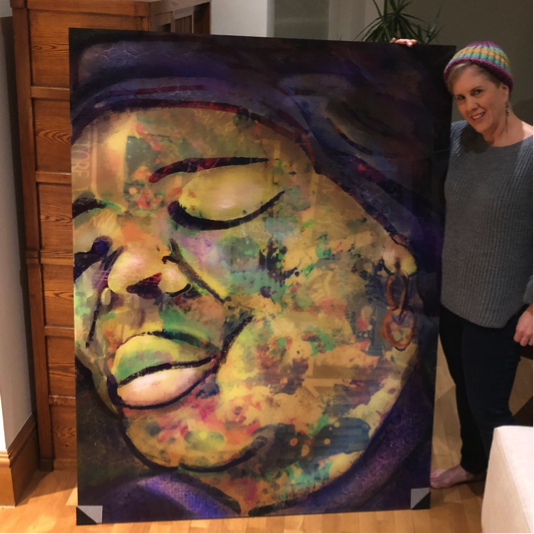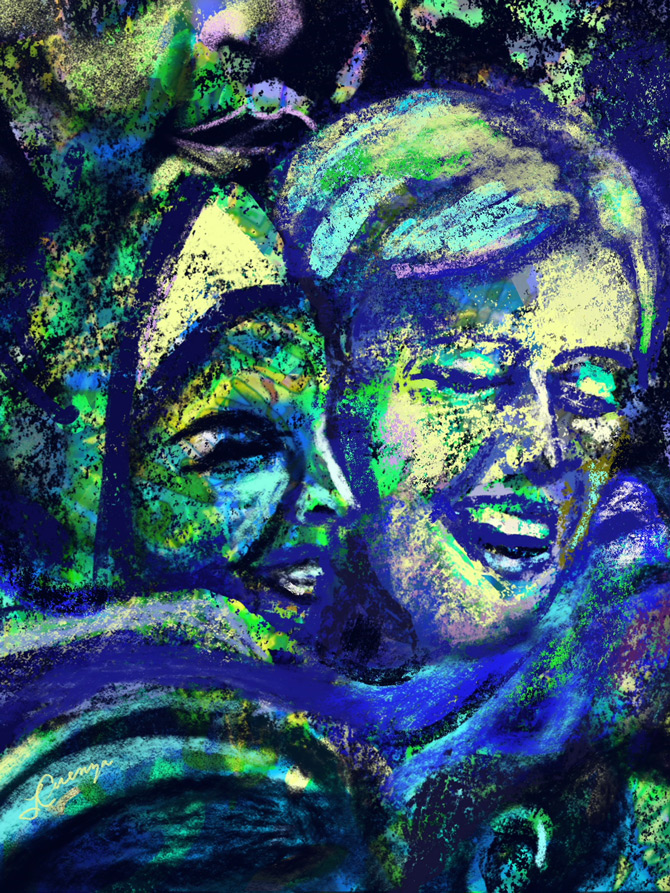When artist Lisa Cirenza told us she was donating one of her latest works to Seeds of Peace, we were ecstatic.
Of course, as a member of our Global Leadership Council and a mother of Seeds, Lisa is far from a stranger to us. But it’s rare that we get a chance to talk to her about her craft—or her personal journey.
She had just returned home from a showing in Edinburgh, Scotland, when we spoke, and she was already gearing up for a fresh round of shows. Below are highlights from our conversation, where Lisa talks about how art can help create a culture of peace.

Lisa with her recent piece, “Amina.”
Seeds of Peace: Tell us a little bit about your journey to becoming an artist?
Lisa: I always wanted to be an artist, but my parents were very strict that I become either a doctor, a lawyer, or a scientist. They didn’t see being a Bohemian artist as the best road to success, so much of my training was done in secret. In college, I double-majored in French so I could clandestinely study art in Paris. I used to sneak out to take art classes—that was a huge theme of my life, going out to take class after class. My goal was to amass all the tools in my toolbox, so when I fully launched, I wouldn’t be held back by not knowing how to use the screwdriver.
I was volunteering for Human Rights Watch and they wanted a piece for an auction. I made something for them, but because I didn’t have a name in the art world or an established price range, they wouldn’t take the piece. So I said to them, “I’m going to come back with a name and reputation so my art can do advocacy work and raise funds.”
Shortly after, I was accepted into my first show. The show did really well, and it’s been an amazing, intense whirlwind of two and a half years since then. Now Human Rights Watch will gladly take a piece I donate to them for an auction!
Especially in our current environment, where we’re surrounded by instantaneous answers and news, it’s important that we visually expose people to questions that they may not have considered before. To encourage people to create genuine dialogue.
Seeds of Peace: Walk us through your artistic process. What inspires you? What is your art about?
Lisa: The heart of all of my work is empathy. One of my most well-known works is a series on the Tube in London. I find the Tube to be a microcosm of multicultural nexus. Despite our differences, we all have the same purpose—get from point A to point B. In the Tube, two people you would never see in the same room together will share an armrest.
I’ve learned the value of listening and the value of not assuming that your narrative is the only narrative. So my art is about asking, “What is the other person’s narrative?”
Seeds of Peace: How can art transform conflict?
Lisa: The Tube isn’t a conflict region, but the people occupying that space are often in conflict. I’ve had people see my work and tell me they never rode the subway the same way again. That my art made them be present in the moment, made them consider for the first time what the backgrounds and stories were of each of the commuters around them. I personally cannot change the world at a high level. But if one person is kind to someone in the Tube because of me, that’s a huge victory.
I also think art has a crucial role of slowing people down. Especially in our current environment, where we’re surrounded by instantaneous answers and news, it’s important that we visually expose people to questions that they may not have considered before. To encourage people to create genuine dialogue. I don’t think art should give answers; it should ask questions and have the viewers ask questions.

Lisa’s work is in corporate and private collections throughout the world, and includes commissions for Apple, Stanford Hospital, Human Rights Watch, and Stockton mayor Michael Tubbs. Her next showing is at Oxford in May, and she will be in an international residency this summer. You can check out her art at www.cirenza.com.

